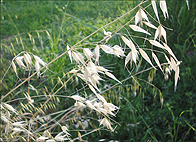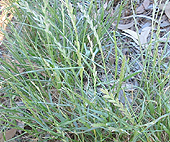module 3
Weed economics and decision making
Objectives
At the end of this module, you will be able to:
- understand the main ways in which weeds cause financial losses to crop production and how these losses can be determined
- understand the major factors that are involved in making decisions about managing weeds in order to reduce the impact of weeds
- understand how to assess the benefits derived from managing weeds
Module outline
- Introduction
- Economic cost of weeds
- Objectives of weed management
- Controlling versus managing weed populations
- Social issues and weed impacts
- Summary
- References and further reading
Introduction
Weeds are responsible for major economic losses in agriculture and the natural environment of Australia. These losses have been estimated for agriculture as exceeding $3.3 billion annually; a value equivalent to the national average net annual farm production. Consequently the losses due to weeds are enormous. However, there is ample opportunity to improve the efficiency of production through better management of weeds.
Economic cost of weeds
While weeds are responsible for considerable costs to agriculture and the environment, it is often difficult to properly assess these costs. However, the cost of weeds directly influences weed control decision-making in agriculture. The following reading discusses approaches to estimating the costs of weeds. This includes a range of models and decision-making tools to aid producers in deciding when to control weeds and how much control to implement. It is important to note that many crop producers tend to be conservative with regard to weed control. The producers realise that a few weeds can produce a large number of seed to infest the field in the next year (see also Module 9 'Cropping weeds' in this manual)
|
Objectives of weed management
One of the first decisions a farmer has to make is to determine their weed management objectives. These can be grouped into four main categories:
Table 3.1 Weed management options
| Objective | Description |
| Quarantine | keep out a weed that does not occur the property |
| Eradication | eliminate a weed from the property |
| Containment | confine a weed to certain parts of the property |
| Reduction | lessen weed densities on the property |
Reducing weeds is by far the most common policy adopted on farms. The extent to which weeds should be reduced is the key question that engages the farmer in further decision making and which determines the economic outcome of the farming operation.
To appreciate some of the complexities of the economic benefits of weed management we need to consider the likely impacts of intervention on the population dynamics of the weeds.
Controlling versus managing weed populations
In managing weeds a very important distinction needs to be drawn between
- new infestations, and
- established populations.
There are two approaches to controlling weeds:
- therapeutic, and
- prophylactic.
Table 3.2 The basic approaches to controlling weeds
| Therapeutic approach | Prophylactic approach |
| Aims to suppress an infestation or symptom (the visible weeds) | Aims to prevent infestations or symptoms from re-occurring |
| Attempt to reduce losses in the current crop by treating infestations | Drastically reduce populations to prevent a re-occurrence; a result that many consider is unachievable and unaffordable |
| A 'band aid' approach to management which may well prevent serious losses, but which mostly fails to solve the problem | Management directed at preventing problems is likely to be more profitable in the long term. |
| A corollary to this is the regular treatment of crops in anticipation that weeds will reinfest and cause losses | |
| Attempts to maximise profits in the current year, or season, and ignores the consequences of actions on what happens to weeds in future years. | By managing with an intention of preventing future problems, initial weed control costs may be high but these could be outweighed by benefits from fewer weed problems in later years. |
It is important to understand that ‘a population’ consists of more than the current infestation of visible plants, it also includes the seed bank (a reservoir of propagules, which are mostly invisible in the soil).
It follows that the extent to which a weed can reinfest a location will generally be determined by the size of the seed bank and so weed problems can be minimised by adopting a management program that reduces populations, particularly the seedbank. Consequently, management of populations implies that changes in weed numbers across growing seasons, that is population dynamics, need to be considered.
Social issues and weed impacts
In addition to the costs to producers, there are a range of other costs and impacts of weeds. Undesirable impacts of a producer’s failure to control weeds that then cause infestations on a neighbours land, may provide additional costs to producers over which they had no control.
The following reading analyses the impacts of weed control or the failure to control weeds and shows how these affect producers, other land owners and the public. You should also note that there may be unforseen negative impacts of controlling weeds.
|
Summary
Weeds are a significant cost to Australia, both for agriculture and in other areas. Costs include:
- losses in crop production
- contamination of grain
- the costs of control.
The major losses caused by weed competition can be estimated using damage function models. Most weed control decisions in agriculture are currently made on a single year basis, which has proven to be unsustainable. These decisions are complex and involve several elements of risk.
A more sustainable approach is to aim to minimise weed populations over the longer term, which can lead to greater economic benefits. There is growing interest in reducing the cost of weed control by:
- increasing the level of precision to determine the rate of herbicide applied
- restricting application to those parts of a field where weeds occur.
A producer should attempt to assess the likely benefits from weed control to assist him/ her in deciding whether or not to undertake control. The simplest tool for this is a gross margin analysis.
Activity 3-1 |
References and further reading
Auld, BA, Menz, KM and Tisdell, CA 1987, Weed Control Economics, Academic Press, London.
Black, ID and Dyson, CB 1990, ‘An economic threshold model for spraying herbicides in cereals’, Weed Research, vol. 33, pp. 279-290.
Charles, GW 1991, ‘A grower survey of weeds and herbicide use in the New South Wales cotton industry’, Australian Journal of Experimental Agriculture, vol. 31, pp. 387-392.
Coble, HD and Mortensen, DA 1992, ‘The threshold concept and its application to weed science’, Weed Technology, vol. 6, pp. 191-195.
Cousens, R 1985a, ‘A comparison of empirical models relating crop yield to weed and crop density’, Journal of Agricultural Science, vol. 105, pp. 513-521.
Cousens, R 1985b, ‘A simple model relating yield loss to weed density’, Annals of Applied Biology, vol. 107, pp. 239-252.
Cousens, R 1987, ‘Theory and reality of weed control thresholds’, Plant Protection Quarterly, vol. 2, pp. 13-20.
Cousens, R, Brain, P, O’Donovan, JT and O’Sullivan, PA 1987, ‘The use of biologically realistic equations to describe the effects of weed density and relative time of emergence on crop yield’, Weed Science, vol. 35, pp. 720-725.
Dorr, GJ and Pannell, DJ 1990, ‘Economics of improved spatial distribution of herbicide for weed control in crops’, Crop Protection, vol. 11, pp. 385-391.
Jones, R, Alemseged, Y, Medd, R and Vere, D 2000, The distribution, density and economic impact of weeds in the Australian annual winter cropping system, CRC for Weed Management Systems, Glen Osmond, SA.
Lotz, LAP, Christensen, S, Cloutier, DC, Fernandez Quintanilla, C, Legere, A, Lemieux, C, Lutman, PJW, Pardo Iglesias, A, Salonen, J, Sattin, M, Stigliani, L and Tei, F 1996, ‘Prediction of the competitive effects of weeds on crop yields based on the relative leaf area of weeds’, Weed Research, vol. 36, pp. 93-101.
Medd, RW, Auld, BA, Kemp, DR and Murison, RD 1985, ‘Competitive interactions for cultural control of Lolium rigidum Gaud. in wheat’, Australian Journal of Agricultural Research, vol. 36, pp. 361-371.
Moore, J 1996, ‘Economic factors influencing control and management decisions for annual grasses in crops and pastures’, Plant Protection Quarterly, vol. 11, pp. 217-222.
O’Donovan, JT 1996, ‘Weed economic thresholds: Useful agronomic tool or pipe dream?’, Phytoprotection, vol. 77, pp. 13-28.
Pandey, S and Medd, RW 1991, ‘A stochastic dynamic programming framework for weed control decision making: an application to Avena fatua L.’, Agricultural Economics, vol. 6, pp. 115-128.
Pannell, DJ 1990, ‘Model of wheat yield response to application of diclofop-methyl to control ryegrass (Lolium rigidum)’, Crop Protection, vol. 9, pp. 422-428.
Rimmington, GM and Nicholls, N 1993, ‘Forecasting wheat yields in Australia with the southern oscillation index’, Australian Journal of Agricultural Science, vol. 44, pp. 625-632.
Sindel, BM 2000, Australian Weed Management Systems, RG and FJ Richardson, Melbourne.
Self assessmentDo you know?
|

